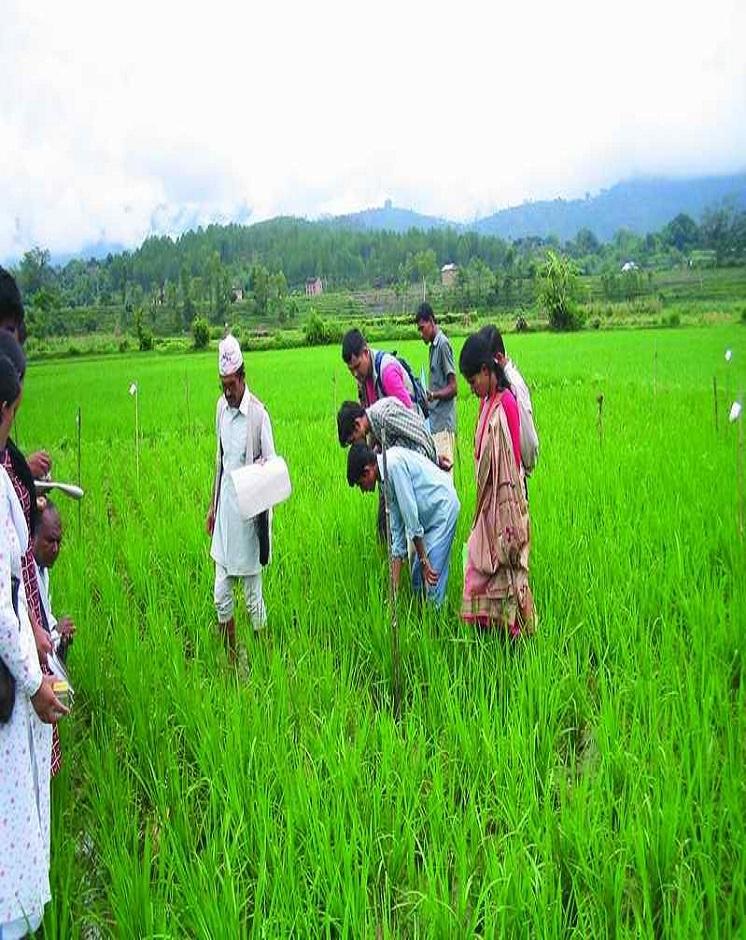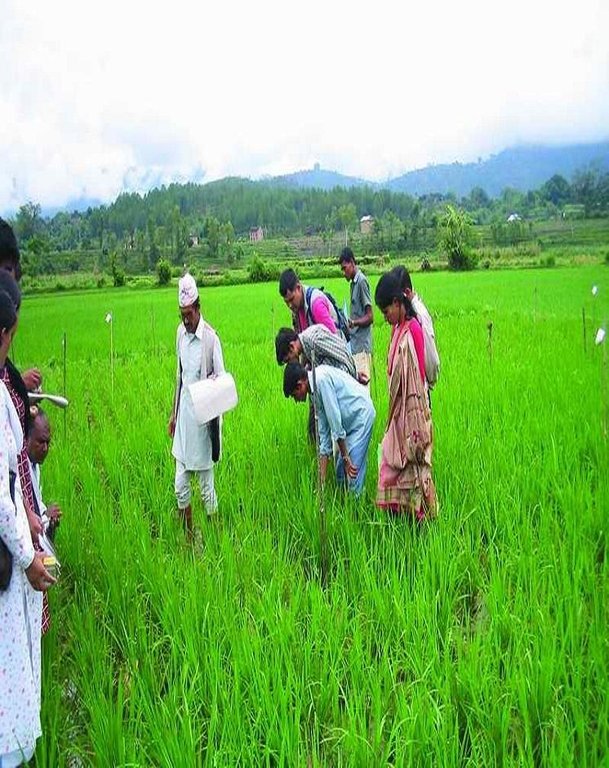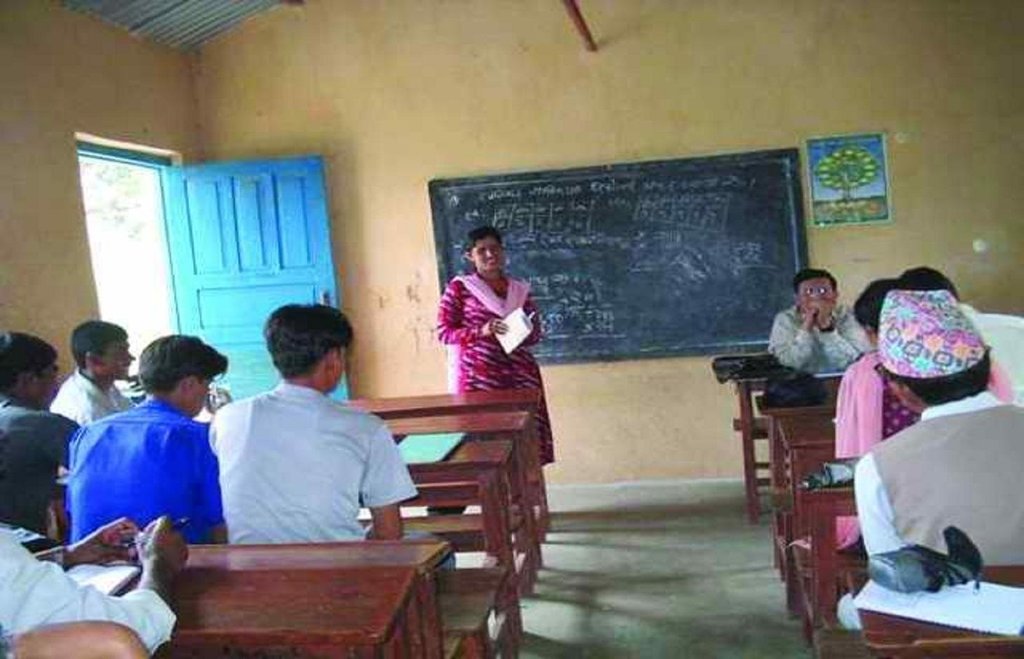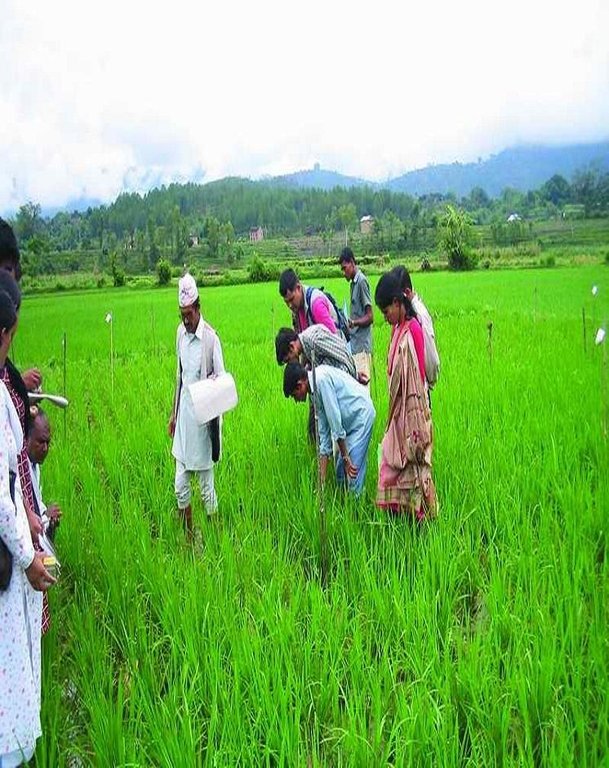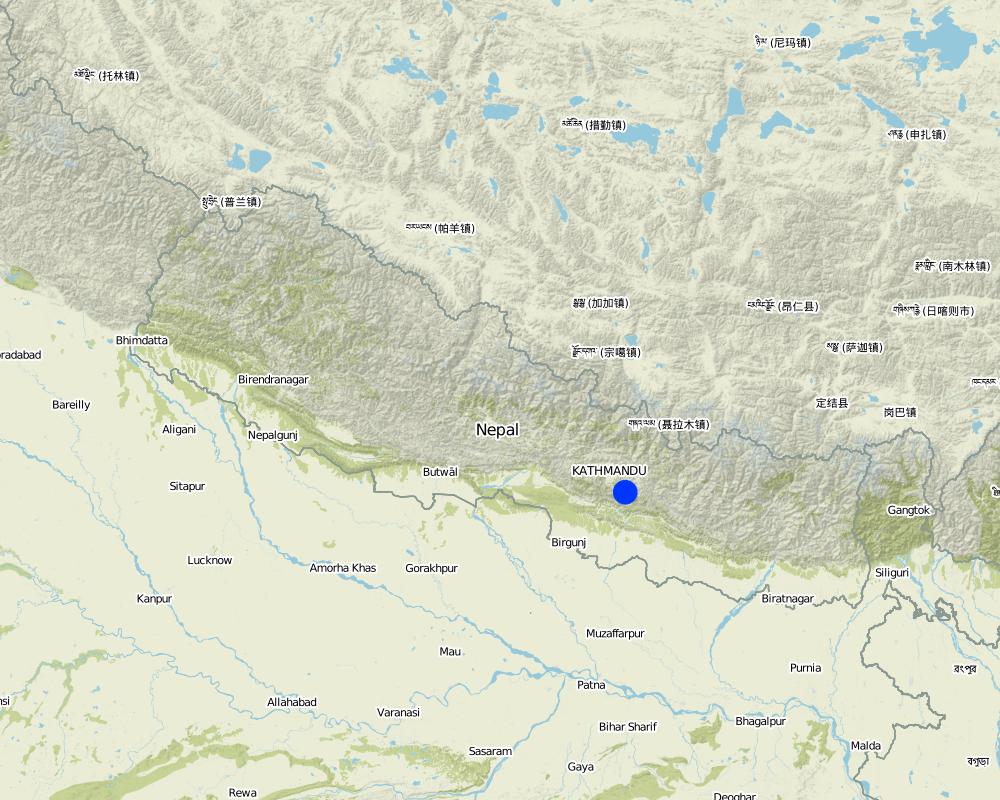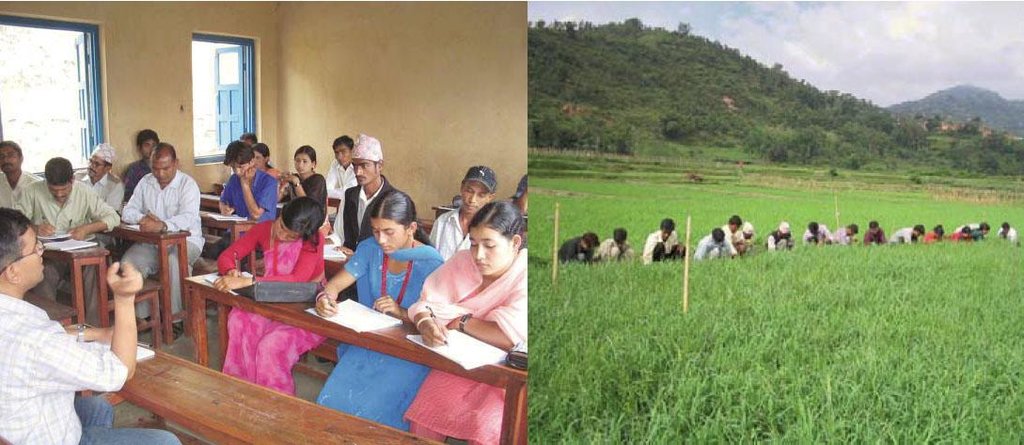Evaluation of the System of Rice Intensification through participatory research and development [Nepal]
- Criação:
- Atualização:
- Compilador/a: Madhav Dhakal
- Editor: –
- Revisor: Fabian Ottiger
Sahabhagitamulak anusandhan ra bikas dwara dhan uttpadan bridhhi garne tarika ko mulyankan (Nepali)
approaches_2550 - Nepal
Veja as seções
Expandir tudo Recolher tudo1. Informação geral
1.2 Detalhes do contato das pessoas capacitadas e instituições envolvidas na avaliação e documentação da abordagem
Especialista em GST:
Nome da(s) instituição(ões) que facilitou(ram) a documentação/avaliação da Abordagem (se relevante)
CDE Centre for Development and Environment (CDE Centre for Development and Environment) - SuíçaNome da(s) instituição(ões) que facilitou(ram) a documentação/avaliação da Abordagem (se relevante)
ICIMOD International Centre for Integrated Mountain Development (ICIMOD) - Nepal1.3 Condições em relação ao uso da informação documentada através de WOCAT
O/a compilador/a e a(s) pessoa(s) capacitada(s) aceitam as condições relativas ao uso de dados documentados através da WOCAT:
Sim
1.4 Referência ao(s) questionário(s) sobre tecnologias da GST
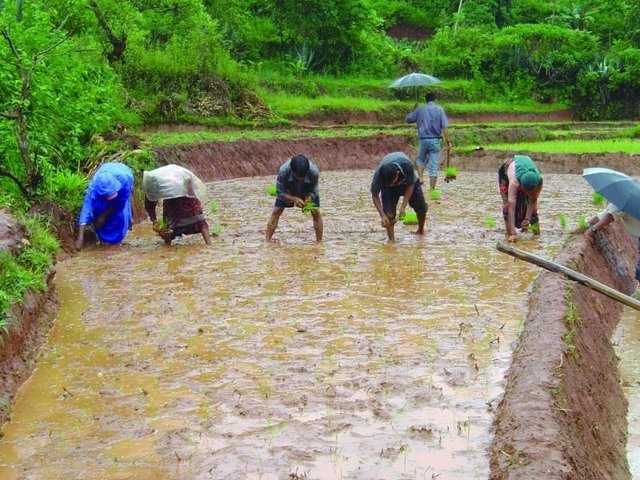
System of Rice Intensification [Nepal]
A method for increasing the productivity of rice by changing the management of plants, soil, water, and nutrients.
- Compilador/a: Madhav Dhakal
2. Descrição da abordagem de GST
2.1 Descrição curta da abordagem
Conducting participatory action research with farmers and district level line agencies for demonstrating, disseminating and scaling up SRI
2.2 Descrição detalhada da abordagem
Descrição detalhada da abordagem:
Aims / objectives: PARDYP pilot tested SRI in the Spice Crop Development Centre (SCDC) at Tamaghat, Kavrepalanchok in 2002. The positive results led the technique to be tried out in 25 farmer’s fields in 2004 to evaluate whether SRI was technically feasible in the Himalayan middle mountains. Based on farmers’ interests and to promote SRI systematically, PARDYP organised interaction programmes between farmers who had and had not used SRI, village level group discussions, farmer-to-farmer visits and farmer-led on-site monitoring and evaluation in 2002, 2003 and 2004.
Methods: In 2005, the emphasis shifted to carrying out research with groups of farmers in a more systematic way and participatory rural appraisal methods and tools were used. The approach was called the SRI farmer field school (FFS) approach. Lead farmers (13 male and 6 female) were trained as SRI trainers and then facilitated village level farmer field schools for testing and promoting SRI. In 2005, SRI farmer field schools were run in 15 villages for about 100 farmers. Each school carried out hands-on training sessions to help farmers understand (1) the basic concepts of SRI and its practices, (2) methods for comparing traditional practices with SRI, and (3) how to observe, analyse and present findings more systematically. Monitoring and evaluation gathered both men’s and women’s perceptions. This also helped establish an informal farmer-learning network in the watershed. Village level discussions, farmer visits, and interaction with staff from the district agriculture offices continued. At the end of the on-farm experiments, a district level farmer’s day was organised to share the experiences gained.
Other important information: To promote wider understanding of the action research and encourage farmers to continue developing and adapting SRI, the project disseminated information about SRI through information, education and communication (IEC) materials aimed at community-level users, and a multi-media package on a CD ROM for the global audience and Nepali policy-makers and administrators. A national exchange workshop was held to share experiences from across the country on the use of SRI.
2.3 Fotos da abordagem
2.5 País/região/locais onde a abordagem foi aplicada
País:
Nepal
Especificação adicional de localização:
Kavrepalanchowk/ Jhikhu Khola watershed
Map
×2.6 Datas de início e término da abordagem
Ano de término (caso a abordagem não seja mais aplicada):
2005
2.7 Tipo de abordagem
- Baseado em projeto/programa
2.8 Principais metas/objetivos da abordagem
The Approach focused mainly on SLM with other activities (Rice cultivation, watersaving, agronomic innovation)
- To demonstrate and evaluate the innovative SRI technique under local conditions with land users' participation. - To inform farmers about the basic concepts, associated principles, and technical know-how related to SRI. - To share knowledge gained on SRI with a wider audience. - To scale up the innovation across larger areas
The SLM Approach addressed the following problems: - Lack of systematic on-farm research for developing a technology that takes into account farmers' needs. - Weak institutional collaboration for technology development, dissemination and scaling up. - Poor soil fertility, limited crop production, and poor irrigation facilities
2.9 Condição que propiciam ou inibem a implementação de tecnologia/tecnologias aplicada(s) segundo a abordagem
Disponibilidade/acesso a recursos e serviços financeiros
- Inibitivo
Government incentives lacking
Treatment through the SLM Approach: The innovation is cost effective and doesn't need additional inputs
Quadro institucional
- Inibitivo
Lack of cordination among land users
Treatment through the SLM Approach: Informal SRI farmers network established with trained human resources.
Quadro jurídico (posse de terra, direitos de uso da terra e da água)
- Propício
The existing land ownership, land use rights / water rights greatly helped the approach implementation: The individual land use rights helped in implementing the technology as there were no conflicts among land users.
Conhecimento sobre GST, acesso a suporte técnico
- Inibitivo
It is not a priority area of line agencies
Treatment through the SLM Approach: Sharing of technical know how with concerned stakeholders
Outro
- Inibitivo
lack of awareness
Treatment through the SLM Approach: Trainings, group discussions , field visits
3. Participação e papel das partes interessadas envolvidas
3.1 Partes interessadas envolvidas na abordagem e seus papéis
- Usuários de terra/comunidades locais
Spices Crop Development Centre and farmer groups
Women are generally busy with in-house work. There was only 30 % women participation. Initially SRI was demonstrated onindividual farmers' field. Working land users were mainly men (about 30 percent were women), villlage level groups were formed.
- Organização não governamental
PARDYP project
- Governo nacional (planejadores, responsáveis pelas decisões)
- Organização internacional
Caso várias partes interessadas foram envolvidas, indique a agência líder:
Concept and orientation - national specialists and implementation of the approach jointly with land users.
3.2 Envolvimento do usuários de terra/comunidades locais nas diferentes fases da abordagem
| Envolvimento do usuários de terra/comunidades locais | Especifique quem estava envolvido e descreva as atividades | |
|---|---|---|
| Iniciação/motivação | Passivo | public meetings; First year's on-station demonstration with results shared at public meetings |
| Planejamento | Participativo | public meetings; Public meetings organised in different villages; villagers selected lead farmers for the training, and orientation meeting held to plan activities |
| Implementação | Participativo | responsibility for major steps; Farmers themselves implemented the activities; the project facilitated the research and arranged logistics |
| Monitoramento/avaliação | Participativo | Measurements, observations and reporting were carried out once a week. At the end of the project, results were evaluated through interviews using questionnaires. Public meeting organised to share results with district level stakeholders |
| Research | Participativo | On-farm and on-station research conducted; information from research station collected by technicians; farmers themselves collected information from their fields |
3.3 Fluxograma (se disponível)
Descrição:
left: Public meeting: an orientation meeting to plan and implement SRI activities. Right: Lead farmers in the demonstration field – an activity of a farmer field school.
Autor:
Madhav Dhakal
3.4 Decisão sobre a seleção de tecnologia/tecnologias de GST
Especifique quem decidiu sobre a seleção de tecnologia/tecnologias a serem implementadas:
- Principalmente especialistas em GST, após consulta com usuários da terra
Explique:
SRI is being tested in many countries in Asia and rest of the world with proven benefits. Project staff shared SRI principles and methods with the watershed-farmers, few of them came forward and tested it to observe the performance in the local condition.
Decisions on the method of implementing the SLM Technology were made by mainly by SLM specialists with consultation of land users. It was tested first at a research station to build confidence of project staff and surrounding villagers, and was then taken to interested farmers' fields
4. Suporte técnico, reforço das capacidades e gestão do conhecimento
4.1 Reforço das capacidades/ formação
Foi oferecida formação aos usuários da terra/outras partes interessadas?
Sim
Especifique quem foi capacitado:
- Usuários de terra
- Equipe de campo/consultores
Tipo de formação:
- Agricultor para agricultor
- Áreas de demonstração
- Reuniões públicas
- Cursos
Assuntos abordados:
The principles associated with SRI, participatory research procedures, and farmers' concerns (men and women).
4.2 Serviço de consultoria
Os usuários de terra têm acesso a um serviço de consultoria?
Sim
Especifique se foi oferecido serviço de consultoria:
- nas áreas dos usuários da terra
Descreva/comentários:
Name of method used for advisory service: Farmer - to - Farmer Extension of SRI; Key elements: Use of local farmers as facilitators, Farmer - to - farmer visits, Public meetings , national workshop; 1) Advisory service was carried out through: projects own extension structure and agents; Extension staff: specifically hired project employees 2) Target groups for extension: land users; Activities: trainings, group discussions, farm visits
Advisory service is quite adequate to ensure the continuation of land conservation activities; Large number of farmers can now implement SRI with confidence, there are 15 local trainers who can train many farmers, which insures the continuation of SRI activities .
4.3 Fortalecimento da instituição (desenvolvimento organizacional)
As instituições foram fortalecidas ou estabelecidas através da abordagem?
- Não
4.4 Monitoramento e avaliação
Monitoramento e avaliação são partes da abordagem?
Sim
Comentários:
bio-physical aspects were ad hoc monitored through observations; indicators: soil condition and irrigation facilities
technical aspects were regular monitored through measurements; indicators: number of tillers, tiller height, climatic conditions
socio-cultural aspects were ad hoc monitored by 0 through observations; indicators: preference for rice varieties
economic / production aspects were regular monitored through observations; indicators: grain and biomass production, cost of production
area treated aspects were ad hoc monitored through measurements; indicators: area of SRI cultivation
no. of land users involved aspects were ad hoc monitored through observations; indicators: frequency of farm visits and record keeping
management of Approach aspects were regular monitored through observations; indicators: training management by farmer field school management sub-committees
4.5 Pesquisa
A pesquisa foi parte da abordagem?
Sim
- Comparision between traditional and SRI methods
Dê mais detalhes e indique quem realizou a pesquisa:
Participatory research at the farmer field schools was a key element of the approach. The schools compared the inputs and outputs of the traditional and SRI methods including the differences in grain and biomass production, the costs and benefits, and the advantages and disadvantages.
Research was carried out both on station and on-farm
5. Financiamento e apoio material externo
5.1 Orçamento anual para o componente de GST da abordagem
Caso o orçamento exato seja desconhecido, indique a faixa:
- 2.000-10.000
Comentários (p. ex. principais fontes de recursos/principais doadores):
Approach costs were met by the following donors: international (SDC, IDRC, ICIMOD): 90.0%; other (Jhikhu Khola farmers): 10.0%
5.2 Apoio financeiro/material concedido aos usuários da terra
Os usuários da terra receberam apoio financeiro/material para a implementação de tecnologia/tecnologias?
Sim
5.3 Subsídios para entradas específicas (incluindo mão-de-obra)
- Agrícola
| Especifique quais entradas foram subsidiadas | Em que medida | Especifique os subsídios |
|---|---|---|
| Sementes | on- station and on- farm demonstration sites only | |
| Fertilizantes | on- station and on- farm demonstration sites only | |
| Biocides | on- station and on- farm demonstration sites only | |
Se a mão-de-obra pelos usuários da terra foi uma entrada substancial, isso foi:
- Voluntário
Comentários:
Farmers worked either as a trainee or as a volunteer.
5.4 Crédito
Foi concedido crédito segundo a abordagem para atividades de GST?
Não
6. Análise de impactos e declarações finais
6.1 Impactos da abordagem
A abordagem auxiliou os usuários da terra a implementar e manter as tecnologias de GST?
- Não
- Sim, pouco
- Sim, moderadamente
- Sim, significativamente
The approach has helped participating farmers to improve soil and water management. They started to apply the recommended dose of chemical fertiliser and improved farmyard manure. The frequency of irrigation was reduced and there were less cases of terrace-riser failure caused by stagnant water. The
Did other land users / projects adopt the Approach?
- Não
- Sim, pouco
- Sim, moderadamente
- Sim, significativamente
A similar approach was used to promote SRI by a few projects in the same district.
Did the Approach lead to improved livelihoods / human well-being?
- Não
- Sim, pouco
- Sim, moderadamente
- Sim, significativamente
Through better management of rice crop
6.2 Principal motivação dos usuários da terra para implementar a GST
- Produção aumentada
Increased (nearly doubled) production
- Lucro (lucrabilidade) aumentado, melhora da relação custo-benefício
Increased production with same or little less cost input
- Consciência ambiental
Improved land and water management
6.3 Atividades de sustentabilidade de abordagem
Os usuários da terra podem manter o que foi implementado através da abordagem (sem apoio externo)?
- Sim
Caso afirmativo, descreva como:
About 35 local land users had adopted the SRI method and previous adopters were continuing to use SRI method. However, some more time may be required for its wider adoption.
6.4 Pontos fortes/vantagens da abordagem
| Pontos fortes/vantagens/oportunidades na visão do usuário da terra |
|---|
| Through farmer-to-farmer fi eld visits, farmers had an opportunity to observe others' fi elds and see the performance of SRI in different locations and conditions. (How to sustain/ enhance this strength: Continue such visits as farmers learn much more from farm visits and from sharing experiences with other farmers.) |
| Pontos fortes/vantagens/oportunidades na visão do/a compilador/a ou de outra pessoa capacitada |
|---|
| Lead farmers served as key resource persons in the village-level farmer field schools. Data from test plots were analyzed by farmers on a weekly basis. This was very effective for promoting the sustainability of SRI. (How to sustain/ enhance this strength: Encourage district level agriculture offi ces to use the skills of lead farmers as resource persons to expand SRI in their districts.) |
| Action research was conducted through farmer field schools and lead farmers were trained in training of trainers programmes. These served as platforms for farmers to share their immediate concerns. Besides analysing and presenting, farmers' skills were also developed. (How to sustain/ enhance this strength: Implement the farmers fi eld school approach during technology implementation to build confi dence of land users and empower them in soil and water conservation.) |
| Participatory methods and tools were applied repeatedly. Farmer visits and village level group discussions were very effective for evaluating SRI. (How to sustain/ enhance this strength: Use participatory tools and methods widely during the technology implementing period) |
| Action research was conducted with farmer groups and individual households. The group approach was more systematic and helped to build confidence of land users in the technology (How to sustain/ enhance this strength: It should be maintained and continued on a regular basis to strengthen land users' involvement) |
6.5 Pontos fracos, desvantagens da tecnologia e formas de superá-los
| Pontos fracos/desvantagens/riscos na visão do usuário da terra | Como eles podem ser superados? |
|---|---|
| A long dry spell meant that the SRI observation plot could not be established near to the lead farmers' fi eld school site, and only 15 facilitators were able to establish observation plots in their villages. | This was due to natural causes (late arrival of monsoon), it can be improved easily if monsoon arrives on time. |
| Pontos fracos/vantagens/riscos na visão do/a compilador/a ou de outra pessoa capacitada | Como eles podem ser superados? |
|---|---|
| Agro-ecosystem analysis, as used at the farmer fi eld schools, became a time-consuming process as participants had to spend much time in preparing presentations. | Pre-planning and pre-preparation of presentation format should reduce the time length |
| Women's participation in the village level workshops was poor (2% at one location and 5% at another) | Encourage women to participate, and adapt programmes to suit their interests. |
| Due to time limits, not all SRI adopters' opinions and experiences could be covered during interaction workshops. The scattered farmer field schools (distance-wise) and the diffi cult political situation meant that exchange visits could not be organised for all schools. | Allocate enough time for such programmes |
7. Referências e links
7.1 Métodos/fontes de informação
- visitas de campo, pesquisas de campo
- entrevistas com usuários de terras
7.2 Referências às publicações disponíveis
Título, autor, ano, ISBN:
Dhakal, M.P. (2005) Farmers' Evaluation of System of Rice Intensifi cation in Middle Mountains of Nepal.Cornell International Institute for Food, Agriculture, and Development (CIIFAD)ICIMOD (2007) Good Practices in Watershed Management, Lessons Learned in the Mid Hills of Nepal. KathmanduIRRI - International Rice Research Institute.
Disponível de onde? Custos?
ICIMOD, SRI.URL: http://ciifad.cornell.edu/sri/countries/nepal/index.htmlICIMODwww.irri.org.
Título, autor, ano, ISBN:
ICIMOD (2007) Good Practices in Watershed Management, Lessons Learned in the Mid Hills of Nepal. Kathmandu
Disponível de onde? Custos?
ICIMOD
Título, autor, ano, ISBN:
IRRI - International Rice Research Institute.
Disponível de onde? Custos?
www.irri.org.
Links e módulos
Expandir tudo Recolher tudoLinks

System of Rice Intensification [Nepal]
A method for increasing the productivity of rice by changing the management of plants, soil, water, and nutrients.
- Compilador/a: Madhav Dhakal
Módulos
Não há módulos


